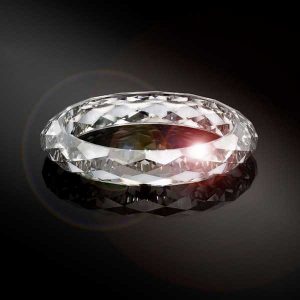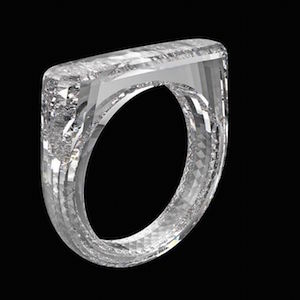
HRD Antwerp has just graded what seems to be the first fully produced lab-grown all-diamond ring.
The Project D ring, fashioned from a single 155 ct. plate of lab-grown diamond, was created by Dutch Diamond Technologies (DDT). The ring is not the same as the (RED) Diamond, designed by Apple’s Jony Ive and Marc Newson, which was announced last year and is currently in production.
The fact that two lab-created rings with the same concept were announced in such a short time seems to be a coincidence, says Ton Janssen, general manager of DDT, which grows diamonds with the chemical vapor deposition (CVD) method, primarily for the industrial market. But he adds that his company has been working on the idea for more than a year.
“For our 10th anniversary, we wanted to do something special. Someone suggested this originally as a joke, to make a ring of this material. But in the end I found it a very good idea.”
It took a while to make it real. The 155 ct. plate took between four and five weeks to grow. Then it took another few weeks to figure out how to create the ring, as the company calculated optimal angles for fire and brilliance. Polishing took another 1,300 hours.
The final Project D ring sports 133 facets and weighs 3.865 cts. It was designed for a size-five finger, unlike the (RED), which is being customized for the purchaser’s individual digits. And while DDT employees have modeled it, Janssen doesn’t consider it all that wearable.
“It’s very brittle,” he says. “This is something that could be worn only on special occasions, not for daily use.”
Still, as a piece of jewelry, it’s striking and different, says Katrien De Corte, vice president of business development of HRD, which graded it E VS1, with very good polish and excellent symmetry.
“When the ring was in the lab, all the graders and the staff came around and looked at it and were very excited,” she says. “No one said it was ugly, everyone loved it. It really is beautiful. When you see it for the first time you never forget it. The facets are really well-placed to get the light refraction.”
It even feels a little different, she says.
“Diamond has thermal conductivity. It immediately absorbs your body temperature. It’s very comfortable to have the ring around your finger. You forget it’s on.”
Janssen says that he didn’t think that either lab or natural diamonds would be better suited for this ring, but his company works only with lab-growns. (In 2011, Shawish created a natural all-diamond ring. ) Until recently it was difficult to grow plates big enough for this kind of object, he says, and that remains a challenge.
“[Producing] this kind of big, better-quality material is not easy,” he says. “We are the only company with access to it.”
For the future, DDT is looking into similar objects—De Corte jokes that she’d love to see an all-diamond earring—though this will probably be DDT’s only ring. DDT plans to sell it, just not yet.
“This started as a joke, but it’s gotten a lot of attention,” says Janssen. “We have a lot of ideas how to proceed.”
As for the (RED) ring, which fetched $256,250 at a Sotheby’s charity auction in December, it is due to be finished in June, says Ye-Hui Goldenson, spokesperson for Diamond Foundry, the material’s grower. It’s not clear whether the currently anonymous purchaser will wear it, but Goldenson says “the buyer purchased this for personal wear, so I am sure it will be seen.”

And while Goldenson doesn’t know if the (RED) ring will be graded, De Corte says that HRD is willing to do it for free.
(Image courtesy of Dutch Diamond Technologies)
- Subscribe to the JCK News Daily
- Subscribe to the JCK Special Report
- Follow JCK on Instagram: @jckmagazine
- Follow JCK on X: @jckmagazine
- Follow JCK on Facebook: @jckmagazine